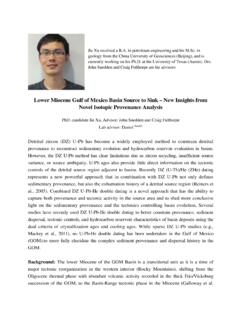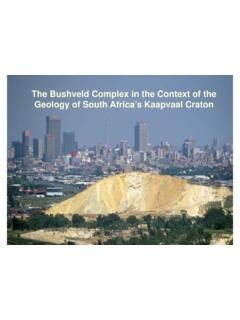Transcription of Sustainability aspects of the Beverley Uranium Mines
1 30 June 2011 UraniumFeature SponsorFeature SSpponsoorIntroductionHeathgate Resources Pty Ltd (Heathgate) operates the technologically advanced in situ recovery (ISR) Beverley and Beverley North Uranium Mines , located about 550 km north of Adelaide, South Australia, on the arid plains between the northern Flinders Ranges and Lake original Beverley Uranium Mine has operated since 2000 under close environmental scrutiny (Jeuken et al, 2008; M rten et al, in press). Since the discovery (see Curtis, Brunt and Binks, 1990) and mining of the original Beverley Uranium resources, additional Uranium deposits have been found in the area and mining is extending over a larger area. In 2009 Heathgate s exploration group discovered the first of several new deposits to the north of Beverley . The Pepegoona and Pannikan deposits are the first ISR Uranium satellite Mines in Australia and form the nuclei of the Beverley North of the Beverley operations is achieved through an environmental management strategy, developed in partnership with regulatory authorities.
2 This strategy focuses on monitoring activities which are undertaken to ensure that the mine complies with regulatory requirements and has an acceptable impact on the environment. The social licence to operate aspect is also important, and extends to relationships with our stakeholders, including the State and Federal governments, the local traditional owners and landholders, our employees and contractors and to the wider community methodHeathgate undertakes mining by the in situ recovery (ISR) process, a form Sustainability aspects of the Beverley Uranium Minesby Peter Woods MAusIMM(CP), Environment, Safety and Health Manager, Heathgate Resources Pty Ltdof solution mining. This has been described in detail in the original EIS and recent Public Environment Reports and in several conference papers (eg Jeuken et al, 2008). ISR Mines have many advantages when compared with traditional Mines since they have: Minimal surface disturbance; No ore surface exposure; No waste rock dumps; No tailings dams; and Greatly reduced radiation exposure to workers and the community at mining removes economic mineralisation from the host ore without the physical removal of ore and overburden.
3 It requires multiple close spaced wells into the ore, pipelines to and from the wells and a surface processing plant, but does not require either underground mine workings or open cut pits, or waste rock dumps and tailings management facilities. The mine s location is shown in Figure 1 and the general arrangement of ISR facilities at Beverley and Beverley North are shown in Figures 2 and 3 mining is feasible where the geological and hydrological characteristics of the orebody are Figure 1. Location of Beverley June 2011 UraniumFeature SponsorFeature SSpponsoorfavourable. This is the case with the Beverley and Beverley North Uranium deposits , where the Uranium is easily mobilised. The mineralised zone occurs in highly permeable sediments that are confined by largely impermeable strata above and below the ore body and the mineralised zone is saturated with the ISR process, natural groundwater from the mineralised zone requires the addition of oxidising and complexing reagents.
4 Oxidising reagents are commonly oxygen or hydrogen peroxide, though other alternatives may be used. Complexing reagents may be acidic or alkaline. Our present operations are an acidic leach, using dilute sulfuric acid with added hydrogen mining solution (lixiviant) is passed via multiple injection wells into a permeable orebody where it mobilises the Uranium contained in the ore. In this process, some of the reagents are consumed. The resulting Uranium rich solution is pumped back to the surface via multiple extraction wells to a Uranium processing plant; either the main plant at Beverley or a smaller satellite plant at Beverley the Beverley processing plant, Uranium is stripped from the solution onto resin beads and held for later precipitation, drying and packaging. At Beverley North Uranium loaded resin is trucked to the main plant at Beverley ; at Beverley the whole process takes place in the main plant.
5 The barren mining solution is refortified to replace used reagents and recycled back to the injection wells. Within any given area, this cycle continues until the Uranium remaining in the ore is depleted to uneconomic levels. Typically mining solution is circulated 50 to 100 times through a given patch of mined design and operation of the wellfield controls the flow of mining solution through the mineralisation. Operations are generally limited to only parts of wellfields at any one time, although the whole of each wellfield will eventually be mined during the life of the and extraction wells are closely spaced, at present between 12 40 m apart. Within the active mining area at Beverley North, the volume of solutions extracted is slightly more than the volume injected. This bleed ensures a slight continuous inflow from the surrounding formation into the active mining area and minimises leakage of mining solutions away from the active mining area (excursions).
6 At Beverley , bleed is small and an essentially neutral water balance is maintained due to the very limited extent of the ore bearing aquifer material at that location, and its lack of connection to regional groundwater is reused wherever possible. In the end, a small volume of saline water cannot be reused. This is disposed of to the mining aquifer at Beverley , which is an isolated sand body not connected to the flowing regional groundwater systems. Originally considered by some to be controversial, because of Figure 2. Schematic of mining at 3. Schematic of satellite mining at Beverley 2011 UraniumFeature SponsorFeature SSpponsoorthe effective isolation of this saline water, the injection of waste water into the mined out aquifer at Beverley has been confirmed as best practice by government reviews (CSIRO Land and Water, 2004; Geoscience Australian and Chief Scientist as quoted by the Minister for the Environment, Heritage and the Arts when announcing the approval of the Beverley extension, 20081.)
7 In contrast, at Beverley North where the Uranium is located in a more regional aquifer, saline water disposal is not part of current approvals and additional measures for the protection of groundwater after mining must be undertaken (Heathgate 2010a, 2011; Kalka, M rten, and Woods, 2011).Regulation and reportingThe operations at Beverley are subject to stringent environmental regulations. The Mines operate in accordance with the environmental standards and procedures initiated through a comprehensive environmental impact assessment process which incorporates input from State and Commonwealth governments as well as from the broader community through consultation. This process is ongoing as continual improvement is sought by all parties. As well as the original Beverley EIS (Heathgate, 1998), thorough reviews and updating of environmental and radiation protection aspects , and public consultation arrangements, were undertaken as part of the Public Environmental Report (PER) processes for the extension of mining at Beverley (Heathgate, 2007) and Beverley North (Heathgate, 2010a).
8 At the same time, significant review and associated updates to its Radiation and Radioactive Waste Management Plans was undertaken (Kutty et al, 2010). The current Mining and Rehabilitation Programs (MARP) for the Beverley and Beverley North Mines are public documents (Heathgate, 2008; 2011) and the South Australian Environment Protection Authority is expected to make the radiation plans public in the near s annual environment report (since 2008 called the Mining and Rehabilitation Compliance Report (MARCR) to meet local regulator guidelines (PIRSA, 2007)) has been available to the public since mining commenced (eg, Heathgate, 2010b). The South Australian Environment Protection Authority is expected to make the radiation reports public in the near title and indigenous relations Heathgate enjoys a strong working relationship with the Adnyamathanha people, who are the traditional owners and Native Title holders for the area where Beverley is located.
9 Mining agreements have been in place for the life of the new Beverley mining agreement including Beverley North was approved by Heathgate and the Adnyamathanha community in May 2010. This ensures the continuance of royalty payments, community payments and employment opportunities for Adnyamathanha people. As a minimum Heathgate meets quarterly with the Adnyamathanha people, and several heritage clearances are undertaken in most years, depending on the level of exploration and the past few years Heathgate has met its target of 20 per cent indigenous employment at Beverley ; this is a goal we will continue try to maintain in the future. At Beverley there is a visitor s centre that displays cultural information, photographs and facts about the Adnyamathanha public consultation and interactionHeathgate s community engagement plans are part of the published MARPs (Heathgate, 2008; 2011) and were subject to review and approval by both state and commonwealth regulators.
10 Formal meetings are held with state regulators on a quarterly basis and with combined state and commonwealth regulators twice a year, together with many informal meetings. Informal meetings are held with local stakeholders in addition to the Adnyamathanha people, notably neighbouring pastoralists and the nearby Arkaroola Wilderness is also a regular participant in industry conferences (see reference list for a selection) and hosts many site visits each year from industry groups, miners and explorers from Australia and other countries, regulators from Figure 4. Wellfield at Beverley (undisturbed desert at far left).35 June 2011 UraniumFeature SponsorFeature SSpponsoorAustralian states, the commonwealth and overseas, regional development boards and non government organisations, including the Friends of the protection and monitoringSustainable operation of the mine includes maintaining acceptable impacts on the environment during operations and following mine closure.




